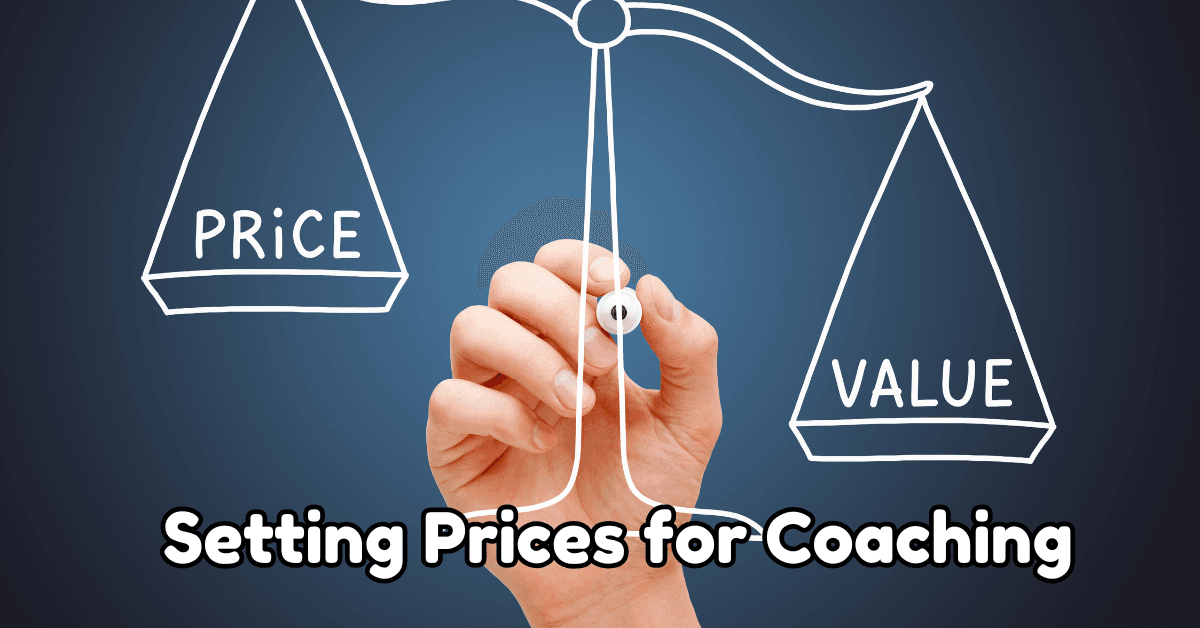
Search Site
CTRL+KSearch Site
CTRL+KPublished: 14 Dec 2024

Setting prices for coaching is one of the most challenging yet crucial aspects of running a successful coaching business. As a coach, your pricing isn’t just about numbers; it’s a direct reflection of the value you provide, the transformation you promise, and the confidence you have in your expertise.
Whether you’re just starting or looking to refine your existing pricing strategy, finding the balance between charging too much or too little can feel overwhelming. Underpricing might leave you overworked and undervalued, while overpricing can deter potential clients before they even see the results you can deliver.
In this guide, we’ll explore practical strategies for setting prices for coaching, from understanding key pricing models to creating irresistible packages that highlight your unique value.

The way you price your coaching services goes beyond numbers—it tells a story. It communicates who you are, what you offer, and the results your clients can expect. Here’s why getting your pricing right is so critical:
Setting prices for coaching directly reflects the results and transformation you bring to your clients. Pricing too low may imply a lack of confidence in your services, while pricing too high without clear value might alienate potential clients.
Your pricing serves as a filter, attracting clients who are willing and able to invest in their personal or professional growth. By setting clear, intentional rates, you avoid time-wasters and focus on working with clients who are serious about achieving their goals.
A well-structured pricing strategy ensures that you’re not only meeting your financial goals but also sustaining your energy and passion for coaching. Setting the right prices allows you to work smarter, not harder, while delivering exceptional results.
When it comes to pricing your coaching services, there are three primary models to consider. Each offers distinct advantages depending on your goals, experience, and target market.
The hourly rate model is the most straightforward option, especially for new coaches.
Example: A life coach charges £100 per hour for individual sessions.
A retainer model provides clients with ongoing access to your expertise for a set monthly fee.
Example: A business coach offers a monthly retainer for £1,500, which includes two sessions and unlimited email support.
Package pricing focuses on delivering a specific transformation over a set timeframe, making it the most popular and effective model for many coaches.
Example: A health coach offers a 3-month program for £3,000, including six sessions, custom meal plans, and weekly accountability check-ins.
Why Package Pricing Stands Out:
Package pricing emphasises the outcomes clients can expect, shifting the focus from “what you’re worth” to the value of the results you deliver. This approach aligns your services with clients’ goals, making it easier to justify your rates.
Determining the right price for your coaching services involves a blend of strategy, self-awareness, and market insight. Below are three strategies to help you establish a pricing model that works for you and your clients:
This strategy is perfect for new coaches who are looking to quickly gain clients, build testimonials, and establish their brand. The goal is to “penetrate” the market by offering lower initial rates.
If you’re aiming to replace your current income, necessity pricing ensures your coaching business is financially sustainable.
This approach helps you stay focused on balancing your workload and income while avoiding burnout.
For experienced coaches, premium pricing allows you to position your services as high-value and attract clients who are willing to invest significantly in their transformation.
Tip: Experiment with different strategies over time to find the approach that aligns best with your goals and audience.

The right pricing strategy depends on several key factors. Understanding these will help you set rates that feel fair to you and attractive to your clients.
Start by calculating how much you want to earn monthly, then work backward to determine how many clients or packages are required to meet that goal. This ensures that your pricing aligns with your financial needs.
Understand your target market’s willingness to pay. Research competitors in your niche and geographic area to gauge average rates. Consider factors like demographics, industry, and the specific pain points your clients face.
Your experience and the results you deliver significantly impact your pricing. Coaches who can demonstrate tangible client success (e.g., career promotions, weight loss, or increased revenue) can command higher rates.
While the online nature of coaching has blurred geographic boundaries, cost of living and market demand still influence pricing. For instance, clients in metropolitan areas may expect higher rates than those in rural regions.
One of the most overlooked factors is how confidently you can quote your prices. If you hesitate or doubt your worth, clients may pick up on that uncertainty. Practice stating your rates until you feel assured in their value.
One of the most debated topics among coaches is whether to display prices on your website. The answer largely depends on your goals and stage of business.
A Balanced Approach:
If you’re just starting, consider not listing exact prices but including a phrase like, “This is a significant investment.” This sets expectations while encouraging prospective clients to initiate a conversation.
As you become more established, you can test listing a price range or package starting points (e.g., “Packages start at £3,000”) to refine your client base further.
When setting prices for coaching, well-structured packages can help potential clients see the value of working with you. Here are examples to inspire you:
Tip: Packages with clear, tangible outcomes are more likely to resonate with clients and justify higher price points.

The Desire — Solution — Package (DSP) framework is a simple yet effective way to design coaching packages that meet client needs while aligning with your business goals.
Understand your clients’ primary challenges. For example:
Uncover what your clients truly want. Examples:
Define the results your coaching will deliver. Examples:
Design a package that bridges the gap between your clients’ current situation and desired outcomes. Clearly outline what’s included and the timeframe.
Base your price on the value of the transformation you provide, not just the time you spend. Use market research and your expertise to justify your rates confidently.
Confidence is key when setting prices for coaching. Clients need to feel that you believe in the value you offer. Here’s how to build confidence in your pricing:
The Fleximize article on pricing strategies offers valuable insights that apply to the coaching industry:
By integrating these proven strategies, you can refine your pricing approach and attract clients more effectively.
Setting prices for coaching is a skill that evolves with time, experience, and confidence. It’s not just about finding a number; it’s about communicating the value you bring and ensuring your business is financially sustainable.
By exploring different pricing models, crafting high-value packages, and leveraging frameworks like DSP, you can create a pricing strategy that aligns with your goals and resonates with your ideal clients.
If you’re ready to take your coaching business to the next level, share your thoughts below or explore additional resources on If I Grow. For more general pricing strategies, check out the Fleximize article on pricing strategies.
Remember: Your prices are a reflection of the transformation you provide. Set them confidently, communicate your value, and watch your coaching business thrive.
No results available
Reset